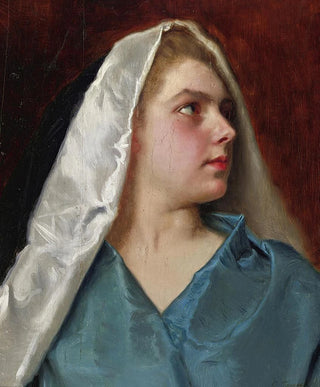Art print | Woman in coat - Gustave Jean Jacquet


View from behind

Frame (optional)
Femme at Coat - Gustave Jean Jacquet – Captivating Introduction
In the world of art, some works manage to capture the very essence of humanity, transcending time and space. "Femme at Coat" by Gustave Jean Jacquet is one of those creations that fascinate and move. Painted at the end of the 19th century, this piece embodies the delicacy and depth of human emotions through the gaze of a woman whose mystery blossoms in the light. The composition, both intimate and universal, invites the viewer to reflect on the story, identity, and feelings of the depicted characters. Contemplating this work transports us to a world where every brushstroke tells a story, where each shade of color evokes an emotion.
Style and uniqueness of the work
Jacquet's style is distinguished by its striking realism and its ability to capture the subtleties of light. In "Femme at Coat," the texture of the coat and the delicacy of the woman's face are rendered with remarkable precision. The interplay of shadow and light highlights the contrast between the softness of the protagonist's features and the depth of her gaze, creating an atmosphere that is both serene and unsettling. The color palette, subtly chosen, evokes a gentle melancholy, while the meticulous details demonstrate exceptional craftsmanship. This art print does not merely depict a female figure; it explores the human psyche, inviting the viewer to feel an emotional connection with the woman, to guess her thoughts and dreams.
The artist and his influence
Gustave Jean Jacquet, a French artist of the 19th century, made his mark with his innovative approach to painting. Trained at the École des Beaux-Arts in Paris, he was influenced by the great masters of his time, while developing a personal style that is uniquely his own. His works, often centered on the female figure, reveal a fascination with the beauty and complexity of the human soul. Jacquet succeeded in establishing himself in the artistic world through his ability to combine rigorous technique with sensitivity. His influence extended beyond his era, inspiring many

Matte finish

View from behind

Frame (optional)
Femme at Coat - Gustave Jean Jacquet – Captivating Introduction
In the world of art, some works manage to capture the very essence of humanity, transcending time and space. "Femme at Coat" by Gustave Jean Jacquet is one of those creations that fascinate and move. Painted at the end of the 19th century, this piece embodies the delicacy and depth of human emotions through the gaze of a woman whose mystery blossoms in the light. The composition, both intimate and universal, invites the viewer to reflect on the story, identity, and feelings of the depicted characters. Contemplating this work transports us to a world where every brushstroke tells a story, where each shade of color evokes an emotion.
Style and uniqueness of the work
Jacquet's style is distinguished by its striking realism and its ability to capture the subtleties of light. In "Femme at Coat," the texture of the coat and the delicacy of the woman's face are rendered with remarkable precision. The interplay of shadow and light highlights the contrast between the softness of the protagonist's features and the depth of her gaze, creating an atmosphere that is both serene and unsettling. The color palette, subtly chosen, evokes a gentle melancholy, while the meticulous details demonstrate exceptional craftsmanship. This art print does not merely depict a female figure; it explores the human psyche, inviting the viewer to feel an emotional connection with the woman, to guess her thoughts and dreams.
The artist and his influence
Gustave Jean Jacquet, a French artist of the 19th century, made his mark with his innovative approach to painting. Trained at the École des Beaux-Arts in Paris, he was influenced by the great masters of his time, while developing a personal style that is uniquely his own. His works, often centered on the female figure, reveal a fascination with the beauty and complexity of the human soul. Jacquet succeeded in establishing himself in the artistic world through his ability to combine rigorous technique with sensitivity. His influence extended beyond his era, inspiring many






